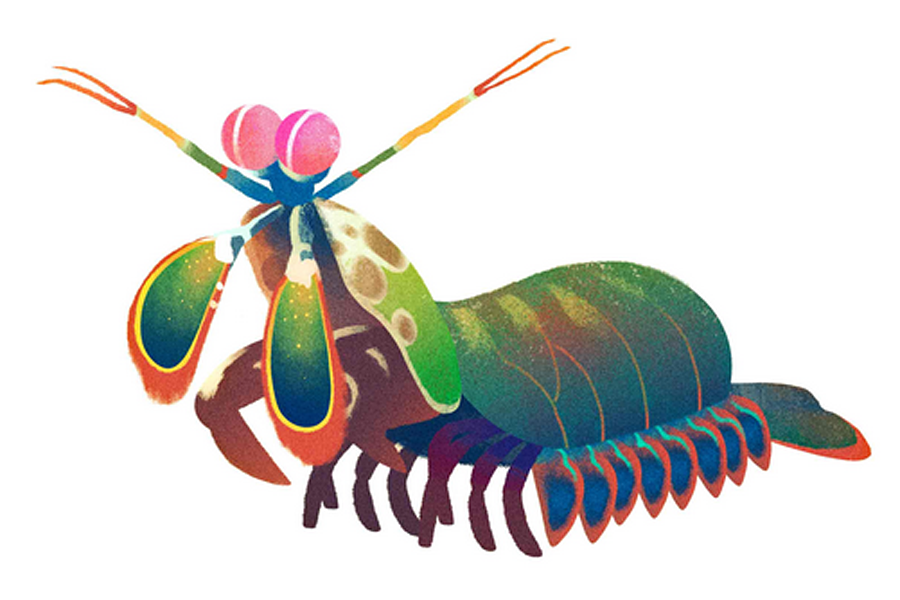Why did Google choose those animals for its Earth Day quiz?
Loading...
Since 1970, Earth Day has drawn national attention to pressing environmental issues. In paying homage to environmental activists and the causes they champion, Google’s homepage channels … Buzzfeed?
Today’s animated Google Doodle directs to a simple personality quiz titled “Earth Day: Which animal are you?” At first glance, the results seem disparate and randomly chosen – you’d be hard-pressed to find two creatures that are less alike than the honey bee and the giant squid. So how did Google choose this host of animal representatives?
Based on five questions with four potential answers each, the quiz pairs you with one of 12 animals – giant squid, honey badger, red capped manakin, komodo dragon, woolly mammoth, pangolin, sea otter, whooping crane, honey bee, cuttlefish, and coral.
You might assume, given the context of Earth Day, that each of these creatures is endangered or threatened. But only five of the 12 – the sea otter, komodo dragon, whooping crane, honey bee, and pangolin – are of serious concern for conservationists (the woolly mammoth, of course, is already extinct).
By contrast, the less-threatened animals tend to be the more remarkable ones. Take the mantis shrimp: While our color spectrum is based on three basic colors, the rainbow-colored mantis shrimp’s is based on sixteen, most of which we cannot perceive. Its powerful front appendages strike fast enough to boil the water around it, easily dismembering prey or shattering aquarium glass. But much of the mantis shrimp’s popularity can be attributed to a humorous depiction in the popular webcomic The Oatmeal.
Like the mantis shrimp, many of these animals score high in Internet virality. The cuttlefish, which can change color and texture almost instantaneously, was a subject in the popular YouTube series “True Facts.” The red-capped manakin, a small bird native to Central and South America, performs a mating dance that looks an awful lot like the moonwalk. And the honey badger, star of its own viral video, is a fixture in Internet culture.
Others on the list merely capture our imaginations. The Komodo dragon, the world’s largest lizard species, looks something like a living dinosaur. Researchers come ever-closer to cloning the woolly mammoth, thus resurrecting a long-extinct giant that walked alongside our prehistoric ancestors. The giant squid is firmly rooted in legend – stories of monstrous kraken might have been inspired by these gigantic creatures. Recently, a group of marine biologists proposed the giant squid as a symbol of oceanic conservation, similar to the World Wildlife Fund’s emblematic panda.
Like politics, conservation is a game of public appeal. It takes a lot of money to keep a threatened species alive, so environmental activists tend to focus on more marketable animals. Giant pandas, bald eagles, and humpback whales are all considered “charismatic megafauna” – large animals with broad appeal with which activists can secure funding. A study published in Biodiversity and Conservation showed that the covers of US nature and conservation magazines mostly featured large-bodied mammals and birds over reptiles, amphibians, and invertebrates.
But to what extent is it our place to determine which animals live or die? Some conservationists argue that too much money is spent protecting cute animals, like the giant panda, while more ecologically important creatures fall through the cracks. But some organizations have begun speaking up for Earth’s not-so-cute inhabitants. The UK-based Ugly Animal Preservation Society, for example, pairs with comedians to advocate for the endangered species list’s unsightly occupants.
It’s an important and thankless job, but maybe the Internet – and Google – can help. Not long ago, bees were considered pests. Today, they are seen, rightfully, as essential pollinators of a third of our food supply. This paradigm shift was prompted by news stories, but also by webcomics and videos. Wealthy donors used to decide which animals to save, but widely-circulated online media can now sway the court of public opinion – and work towards the conservation of important animals, regardless of how cute they are.






